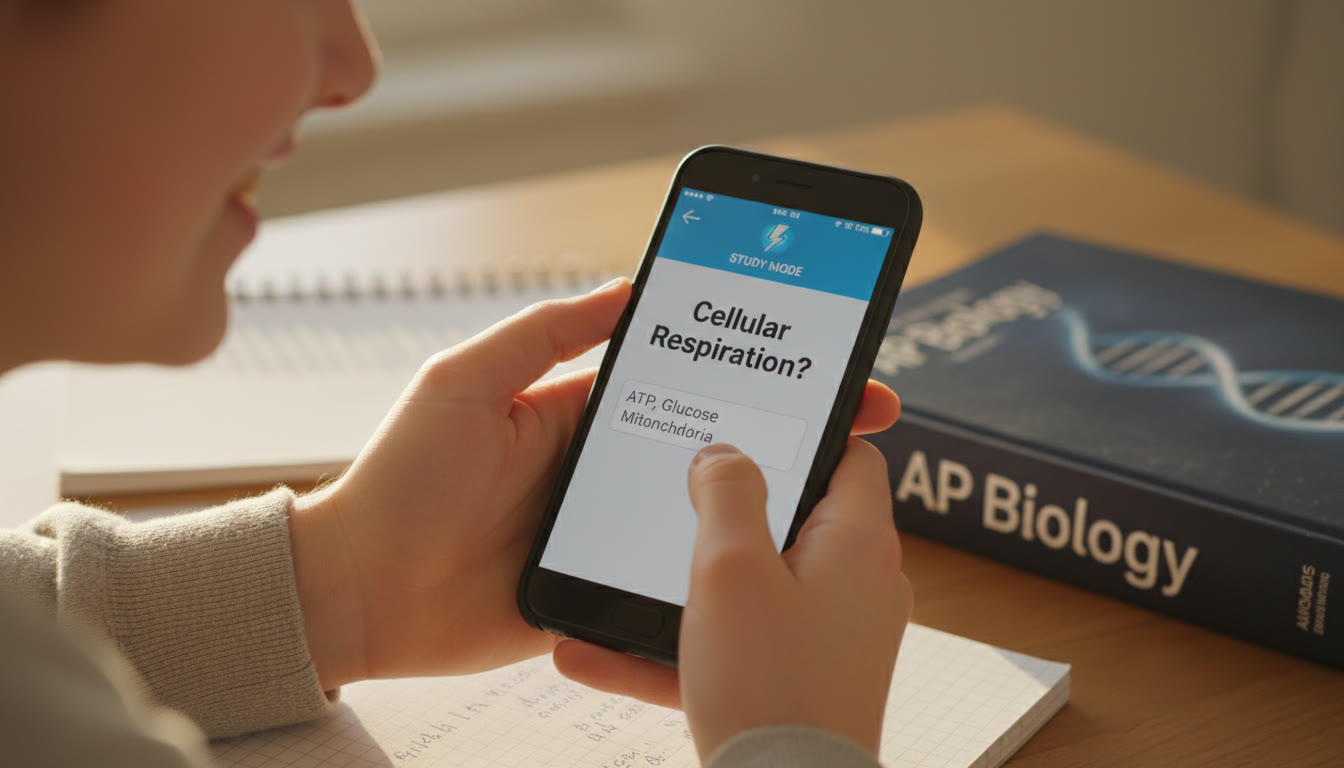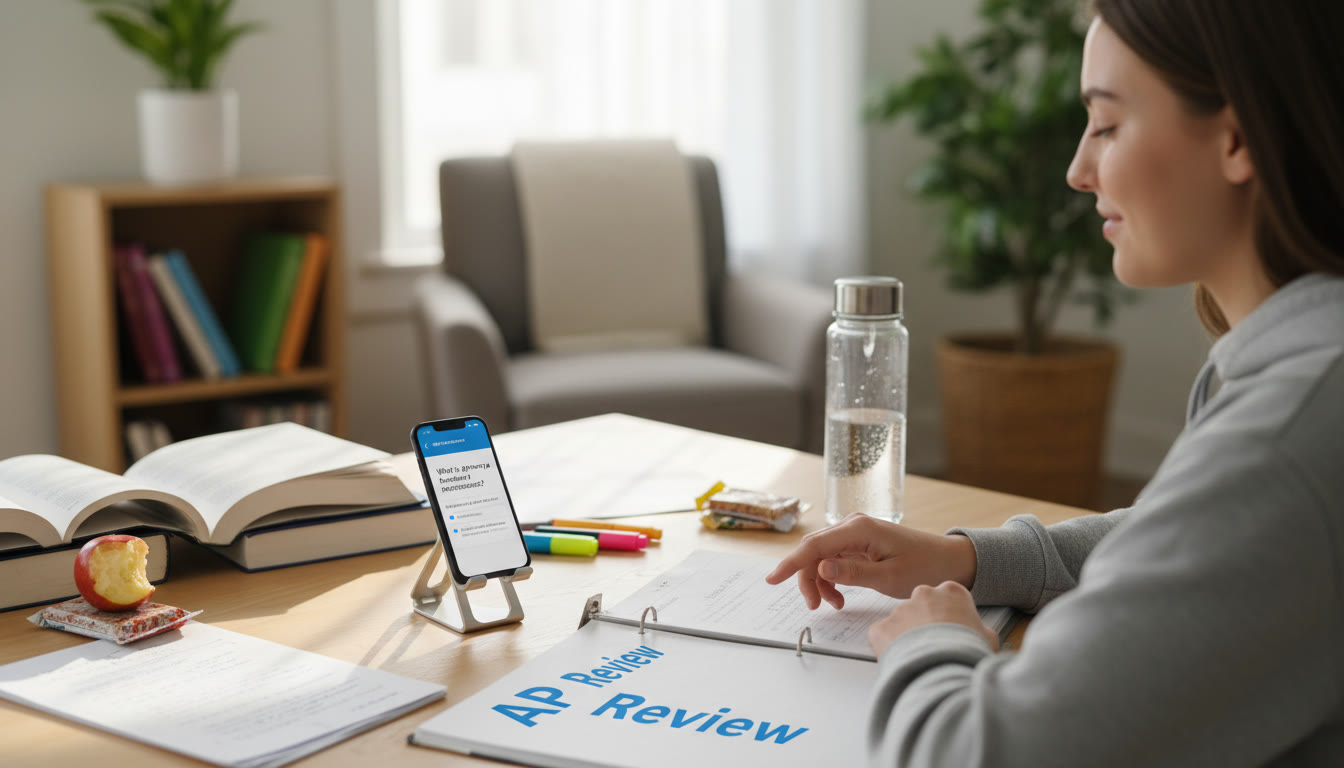Why Mobile Micro-Study Works for AP Students
Picture this: you’re between classes, waiting for the bus, or have five minutes before soccer practice starts. That tiny sliver of time—when used well—adds up. Mobile micro-study is the practice of learning with short, focused sessions using a smartphone or tablet. For AP students juggling classes, extracurriculars, and college planning, micro-study offers a realistic, low-friction way to keep momentum without burning out.
There’s a science behind it: spaced repetition and retrieval practice are two of the most robust memory strategies we have. Micro-study leverages both. Instead of cramming in four-hour marathons, you pepper your day with targeted retrieval: short stretches of recalling, testing, and reviewing. Over weeks and months, those tiny retrievals compound into lasting understanding.

How Micro-Sessions Beat Marathon Study Sessions
- Lower activation energy: It’s easier to commit to 5–10 minutes than two hours.
- Frequent retrieval: Short, repeated recall strengthens memory more than a single long review.
- Reduced cognitive fatigue: Brief sessions keep attention sharp and reduce diminishing returns.
- Flexibility: Micro-sessions fit into varied schedules—commute, lunch, study hall, or between classes.
- Better long-term retention: Spaced practice moves knowledge from short-term to durable memory.
Flashcards and Snippets: The Core Tools
When we say flashcards, we mean more than just a vocabulary deck. For AP courses—think Biology, U.S. History, Calculus, English—flashcards can capture formulas, argument structures, primary-source facts, synthesis prompts, and quick graph interpretations. Snippets are even smaller: one-sentence summaries, mini-explanations, mnemonic cues, or a single worked example you can mentally rehearse.
Types of Mobile Study Cards to Build
- Definition Cards: Key terms, dates, and people with concise context on the reverse.
- Concept Cards: Short explanations of major ideas (e.g., natural selection in Biology).
- Application Cards: One-sentence prompts that require applying a concept to a new situation.
- Formula/Process Cards: Equation on one side, step-by-step application on the other.
- Argument Structure Cards: Thesis + evidence + analysis templates for AP Lang and History essays.
- Image-Based Cards: Diagrams, map snippets, or graphs with one targeted question.
Designing a Micro-Study Routine That Fits Your Life
A solid micro-study routine looks less like a rigid schedule and more like a series of intentional tiny rituals. The goal is consistency and variety: keep the sessions short, but rotate formats so every session challenges your brain in a slightly different way.
Sample Daily Micro-Study Plan (for a Busy AP Student)
| Time | Duration | Activity | Purpose |
|---|---|---|---|
| 7:15–7:25 AM | 10 min | Flashcard warm-up (definitions) | Activate prior knowledge; quick retrieval |
| Between classes | 5–8 min | One snippet: mini-explanation or worked problem | Practice application under time pressure |
| Lunch | 12 min | Quizset: mixed deck (concept + application) | Interleaving practice to strengthen discrimination |
| 5:30–5:40 PM | 10 min | Timed essay planning or formula practice | Build fluency and exam habits |
| Night | 8–12 min | Review missed cards + spaced repetition | Consolidate memory before sleep |
This schedule totals roughly 45 minutes of focused study spread across the day—far more manageable than a single long block and often more effective.
How to Build Better Flashcards
Better flashcards are precise, active, and testable. They should prompt your brain to work—passive reading doesn’t count.
Card-Making Rules That Work
- Keep prompts specific: Ask one question per card—avoid multi-part prompts that freeze recall.
- Make answers active: Instead of writing long paragraphs, include key bullet points or an outline to reproduce.
- Use cues, not full answers: A hint can be more effective than reproducing the entire answer on the front.
- Include examples: For abstract concepts, a real-world example or AP-style question helps transfer knowledge.
- Mix formats: Text, single-image, short audio (for language), and short worked calculations.
- Write your own cards: Creating cards is itself a powerful study event—don’t rely solely on pre-made decks.
Spaced Repetition and Scheduling Algorithms
At the heart of effective micro-study is spacing. Spaced repetition algorithms (SRAs) schedule reviews just as you’re about to forget, which maximizes retention while minimizing time spent. Many mobile flashcard apps implement SRA logic, but you can replicate the basic idea manually: review new cards more frequently at first and increase intervals after each successful recall.
Simple Manual Spacing Model
- Day 1: Learn new card.
- Day 2: Quick review.
- Day 4: Review again.
- Day 8: Review—if recall is strong, move to weekly intervals.
- Monthly: Long-term refresh before exam season.
And remember: when you fail to recall, shorten the interval. The goal is not perfection in a single session but consistent progress over time.
What to Practice in Different AP Subjects
Micro-study adapts to every subject. What you focus on should reflect the skills the exam tests: recall and synthesis for history, problem-solving for math, evidence-based writing for English, and conceptual reasoning for sciences.
Subject-by-Subject Snapshots
- AP Biology: Flashcards for vocabulary, diagrams for cycles (e.g., Krebs), and snippets that connect concepts across units (e.g., how energy flow relates to population dynamics).
- AP U.S. History: Timeline cards, primary-source snippet prompts, and thesis-template cards for practice essays.
- AP Calculus: Formula cards, one-step derivative/integral practice, and short applied problems that force you to pick an approach quickly.
- AP English Language: Rhetorical strategy cards, quick practice prompts for reading passages, and thesis/outline templates for timed essays.
- AP Chemistry: Reaction-type cards, quick stoichiometry snippets, and conceptual cards linking atomic-level ideas to macroscopic observations.
Micro-Assessments: Turning Tiny Sessions into Real Feedback
Micro-assessments are five- to fifteen-question mini-quizzes you can take on your phone. They’re not about grading yourself harshly—they’re about creating honest feedback loops. Build short quizzes that mix card types and then log what kinds of errors you make. That pattern tells you whether you need conceptual review, more practice problems, or strategy work for free-response sections.
How to Turn Mistakes into a Study Plan
- Track error types (definition confusion, calculation mistakes, misreading prompts).
- Group similar errors and make a small focused deck to target those weaknesses.
- Use spaced repetition to revisit the targeted deck more often.
- Every two weeks, take a longer practice set and measure improvement.
Balancing Depth and Breadth with Interleaving
Interleaving—studying several related topics in one session—helps you learn to choose the right strategy for a problem. For AP exams that reward analysis and synthesis (History and English especially), interleaving prevents you from becoming rigid in how you approach prompts.
Example: Interleaving for AP Biology
- Card 1: Cellular respiration concept
- Card 2: Enzyme kinetics problem
- Card 3: Ecology-based application
- Card 4: Experimental design snippet
This mix forces you to identify what kind of thinking each question requires and strengthens your ability to switch mental gears—exactly what AP exams demand.
Using Tech Wisely: Apps, Offline Tricks, and Notifications
Apps make mobile micro-study practical, but the tool is only as good as how you use it. Turn off distracting notifications. Set short daily goals inside the app. Use offline decks so you can study without internet. And favor apps that support active recall, images, audio, and editable scheduling so your decks grow with you—not the other way around.
Notification Strategy That Helps, Not Distracts
- One daily reminder at a consistent time (morning or night) to keep momentum.
- Short “study nudge” windows of 5–15 minutes for quick sessions.
- Turn off social or multi-app notifications during study to protect focus.
Mental Health, Burnout Prevention, and Sustainable Habits
Micro-study is sustainable by design, but it can still be misused. The constant expectation to ‘do just one more card’ can feel like a treadmill unless you set boundaries. Build micro-study as part of a balanced routine that includes exercise, sleep, social time, and undistracted blocks for deep work when you need them.
Healthy Micro-Study Rules
- Cap mobile sessions per day (e.g., no more than 90 minutes total unless in an intensive review week).
- Create phone-free windows: meals and one hour before bed to protect sleep quality.
- Celebrate small wins weekly: finished a deck, improved a quiz score, or wrote a full practice essay.
- Take one weekly deep-study block (60–120 minutes) for complex skills that need focused time.
Real-World Examples: How Students Use Micro-Study Before the AP Exam
Case studies are a great way to imagine how micro-study maps onto real lives. Here are three short, anonymized snapshots that illustrate diverse strategies.
Across the Hall Aisha: The Multi-AP Student
Aisha runs a tight micro-study schedule: 10 minutes before school for quick vocab, two 8-minute decks between classes, and a 20-minute mixed deck in the evening. She uses snippet cards for thesis outlines in AP Lang and diagram cards in AP Bio. By the month before exams she switches to daily 45-minute mixed practice that includes one timed essay.
Weekend Warrior Marcus: The Athlete with Limited Weekdays
Marcus balances sports and AP Calculus. He studies in 5–10 minute bursts while commuting and does two focused 40-minute problem sessions on Saturday. He builds formula cards but practices solving under timed, exam-like conditions during weekend deep blocks. Short daily retrieval keeps formulas fresh during the season.
Senior Scholar Leah: Focused Review and Confidence Building
Leah has one AP exam left and uses micro-study to maintain momentum without stress. Her routine: 12 minutes of targeted flashcards each morning (missed items first), a 10-minute evening review, and one 90-minute mock test every 10 days. This pattern preserves confidence and ensures steady improvement without last-minute panic.
How Personalized Tutoring Enhances Micro-Study
Micro-study is powerful on its own, but one-on-one tutoring can accelerate progress by diagnosing blind spots and tailoring the deck for maximum efficiency. A tutor can help convert vague weaknesses into specific cards, set optimal spacing schedules, and provide accountability without micromanagement.
For example, Sparkl’s personalized tutoring pairs expert tutors with AI-driven insights to create tailored study plans and targeted card sets. That combination helps students focus micro-sessions on the right material, unlock faster improvement, and get feedback that fits a busy schedule.
When to Bring in a Tutor
- If you’re plateauing despite regular practice.
- If you consistently make the same errors on micro-assessments.
- If you need targeted strategy coaching for free-response or synthesis tasks.
- If you want a customized pacing plan leading into the exam.
Checklist: Building Your First 30-Day Mobile Micro-Study Plan
This checklist helps you turn ideas into an executable plan. Modify it to match your schedule and AP subjects.
- Choose 2–3 AP subjects to focus on this month.
- Create three decks: Definitions, Application Problems, and Exam Strategy.
- Commit to 4–6 micro-sessions per weekday (5–12 minutes each).
- Schedule one weekly deep block of 60–120 minutes.
- Every 10 days, take a slightly longer practice set and adjust decks based on errors.
- Keep at least one phone-free hour each day to protect wellbeing.
- Consider a short tutoring check-in every 2–3 weeks to refine the plan.
Quick Templates You Can Use Right Now
Here are two ready-made micro-study templates—one for a content-heavy subject and one for a skills-heavy subject.
AP Content Template (e.g., Biology, History)
- Session 1 (Definitions): 8 mins—20 vocab/concept cards.
- Session 2 (Connections): 10 mins—3 snippet cards that require linking two concepts.
- Session 3 (Application): 12 mins—2 short application problems or primary-source mini-prompts.
- Evening Review: 8 mins—failed cards only.
AP Skills Template (e.g., Calculus, Physics, AP Lang)
- Session 1 (Technique Drill): 10 mins—2 worked problems, reproduce steps from memory.
- Session 2 (Error Analysis): 8 mins—identify and correct mistakes from previous work.
- Session 3 (Timed Practice): 12–20 mins—one mini-problem under time pressure.
- Evening Reflection: 5 mins—note one change to make next session more efficient.
Measuring What Matters: Smart Progress Metrics
Track metrics that show learning, not just effort. Useful measures include percent correct on mixed review, time-to-answer improvements, and growth in complex tasks (e.g., essay scores or multi-step problems). Don’t obsess over daily fluctuations—look for trends over weeks.
Example Progress Table to Maintain
| Metric | Start | Week 2 | Week 4 | Goal |
|---|---|---|---|---|
| Mixed-Deck Accuracy | 62% | 72% | 80% | 85%+ |
| Average Time Per Card | 18s | 15s | 12s | <12s |
| Timed Essay Score (out of 6) | 3 | 3.5 | 4 | 5 |
Final Thoughts: Make Micro-Study Yours
Mobile micro-study isn’t a hack or a shortcut—it’s a sustainable strategy that respects how students live and learn today. It helps you build small, consistent wins that compound into real mastery. Pair it with occasional deep work and targeted feedback, and you’ll find that your understanding becomes both broader and deeper.
If you ever feel stuck, a short tutoring check-in can re-center your plan. Sparkl’s personalized tutoring, for instance, blends one-on-one guidance with AI-driven insights to make micro-sessions more effective: a tutor can help prioritize which cards matter most for your score, design targeted snippets for recurring mistakes, and keep you accountable through the exam season.
Start small. Build a deck. Spend ten minutes tomorrow morning on one targeted micro-session. Over time those ten minutes will be the thing you thank yourself for on exam day.

Action Steps (One-Page Summary)
- Create three decks today: Definitions, Application, Exam Strategy.
- Commit to four micro-sessions a day for seven days—track accuracy.
- Schedule one 60–90 minute deep block for the weekend.
- Review metrics weekly and adjust spacing for missed cards.
- Consider a short tutoring session every 2–3 weeks to refine focus.
Good luck—and remember: consistent little efforts often outscore last-minute marathons. With well-crafted flashcards, smart spacing, and the occasional expert nudge, you can turn spare minutes into real AP mastery.




















No Comments
Leave a comment Cancel